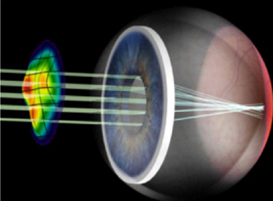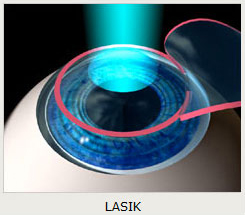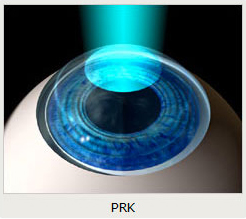 PRK (photorefractive keratectomy) is sometimes referred to as “flapless LASIK”. In fact, PRK is essentially the same procedure as LASIK, except that no flap is created. Instead, the laser is applied directly to the surface of the cornea without a flap. Dr. Shapiro finds the results are identical, but the recovery is longer with PRK than with LASIK. PRK is recommended in situations where it is not safe or not optimal to create a LASIK flap. Customized Wavefront PRK is therefore simply a variation of Customized Wavefront LASIK in which the same wavefront laser is applied to the cornea with all its inherent accuracy — the only difference between the two procedures is whether a flap is created immediately before the laser is applied to the cornea or not.
PRK (photorefractive keratectomy) is sometimes referred to as “flapless LASIK”. In fact, PRK is essentially the same procedure as LASIK, except that no flap is created. Instead, the laser is applied directly to the surface of the cornea without a flap. Dr. Shapiro finds the results are identical, but the recovery is longer with PRK than with LASIK. PRK is recommended in situations where it is not safe or not optimal to create a LASIK flap. Customized Wavefront PRK is therefore simply a variation of Customized Wavefront LASIK in which the same wavefront laser is applied to the cornea with all its inherent accuracy — the only difference between the two procedures is whether a flap is created immediately before the laser is applied to the cornea or not.The sole purpose of the LASIK flap is to provide quick recovery. In some cases, however, it is safer not to make a flap. Such situations would include patients with a cornea that is too thin or too biomechanically weak to support a flap. Patients with certain genetic corneal diseases or dystrophies of the epithelial layer (skin layer) of the cornea also are better treated without a flap.
CUSTOMIZED WAVEFRONT LASIK (FLAP)
 With Customized Wavefront LASIK, a surface flap is created. The flap itself has no optical contribution – it simply is a way of providing access to the cornea for the laser. After flap creation, the Customized Wavefront laser is then used to sculpt the complex optical fingerprint into the cornea. When the wavefront laser sculpting is done, the flap is re-positioned to cover the lasered area and to restore the surface of the eye.
With Customized Wavefront LASIK, a surface flap is created. The flap itself has no optical contribution – it simply is a way of providing access to the cornea for the laser. After flap creation, the Customized Wavefront laser is then used to sculpt the complex optical fingerprint into the cornea. When the wavefront laser sculpting is done, the flap is re-positioned to cover the lasered area and to restore the surface of the eye.
CUSTOMIZED WAVEFRONT PRK (FLAPLESS)
 By contrast, in the case of Customized Wavefront PRK (or “flapless LASIK”), no flap is created. Instead, to gain access to the cornea to apply the wavefront laser, a microscopically thin epithelial (skin) layer is removed from the surface of the cornea. The skin layer that is removed is clear and is only 5 cells thick – about half the thickness of a human hair. This ultra-thin skin layer is one of the quickest healing tissues in the human body – it typically will grow back to cover the cornea in 3 or 4 days. Once the surface skin layer is removed, the same exact Customized Wavefront laser is used to sculpt in the same vision correcting shape as if Customized Wavefront LASIK were being performed. In fact, the wavefront laser does not know whether a flap has been made or not when it sculpts in its new shape — the final optical shape is identical in the two procedures.
By contrast, in the case of Customized Wavefront PRK (or “flapless LASIK”), no flap is created. Instead, to gain access to the cornea to apply the wavefront laser, a microscopically thin epithelial (skin) layer is removed from the surface of the cornea. The skin layer that is removed is clear and is only 5 cells thick – about half the thickness of a human hair. This ultra-thin skin layer is one of the quickest healing tissues in the human body – it typically will grow back to cover the cornea in 3 or 4 days. Once the surface skin layer is removed, the same exact Customized Wavefront laser is used to sculpt in the same vision correcting shape as if Customized Wavefront LASIK were being performed. In fact, the wavefront laser does not know whether a flap has been made or not when it sculpts in its new shape — the final optical shape is identical in the two procedures.
Rather than repositioning the flap after the wavefront laser sculpting is complete, the skin layer is allowed to grow back over the cornea instead. Immediately after surgery, an ultra-thin and ultra-breathable contact lens is placed on the cornea to protect the skin layer as it heals back into position. This ultra-breathable, specialized contact lens has no prescription and is referred to as a “bandage” contact lens since it acts like a clear Band-Aid during healing. The latest generation of bandage contact lenses, coupled with new and advanced pharmacology, makes recovery much easier and quicker than it had been in earlier generations of PRK. Dr. Shapiro places the contact on the eye and the patient typically is unaware of its presence. The patient simply leaves the lens in the eye and Dr. Shapiro will remove it one week after surgery – after the clear and ultra-thin skin layer has grown back.
RECOVERY
The main disadvantage of PRK is its slower recovery compared to LASIK. Typically, it takes about three to four days for the ulta-thin skin layer to grow back to cover the eye. Unlike the nearly immediate recovery of LASIK, PRK patients experience light sensitivity, burning, and tearing for about 24 – 48 hours during those first three to four days – particularly during the second and third day after surgery. Typically, the eye feels irritated rather than painful — and no pain medicines are required. Ideally, patients take a week off work to recover and can typically go back to work after that. Dr. Shapiro often performs PRK surgeries on Tuesday afternoons so that patients can work Monday and Tuesday morning before surgery and then return to work the following Monday – taking off 3 ½ work days in the process.
Once the ultra-thin skin layer has covered the cornea, typically by the third or fourth day , the comfort of the eye becomes essentially perfect – equal to LASIK typically. The vision however, while typically tremendously improved, will usually be a little bit blurry for the next month. The reason for this is that once the skin cells have grown back over the cornea to cover it, their next job is to smooth themselves down into the complex shape inscribed by the laser underneath them. During this time, patients are comfortable and typically able to function quite well. By one month, the skin cells have settled into place so well that most patients describe their vision as thrilling. Most patients are in the 20/20 range of vision at this point. Incremental improvement continues, however, week by week all the way up to approximately 6 months after surgery – although most of the improvement has happened by approximately the one month mark after bandage contact lens removal.
By 6 months, the results of wavefront PRK are typically identical to the results of wavefront LASIK. The only difference has been the speed of recovery.
PRK TECHNIQUE
PRK technique has evolved tremendously over the years, generally advancing in parallel with its LASIK cousin. Not only has laser technology evolved, but also the technique for removing the microscopically thin skin layer from the cornea has advanced as well.
Originally, in the mid to late 1990s, the skin layer was removed by vigorous scraping, which could be traumatic to the eye.
Subsequently, a technique was developed to use a dilute and painless alcohol solution on the eye to swell the skin layer off the underlying cornea. This provided a smoother and more physiologic corneal surface on which to apply the excimer laser sculpture.
In one variation of PRK technique called LASEK, the skin layer is temporarily slid to the side rather than removed. After the laser sculpture, it is then repositioned as an “epithelial flap.” In another variation of PRK technique, a blunt mechanical instrument is used to push the skin layer off to the side while separating it from its underlying attachment to the cornea. This variant of PRK is called epi-LASIK.
The names of these different versions of PRK get confusing as original PRK, modern PRK, LASEK, and epi-LASIK are all sometime simply called PRK. Another overall term that has been suggested for use is “advanced surface ablation,” which is meant to be one term to collectively describe all of these techniques.
RESULTS
As with any surgery, results never can be guaranteed and there are risks to PRK as well as LASIK. PRK and LASIK, however, both are surgeries with very high success rates. Dr. Shapiro presented a landmark study of his techniques for Customized Wavefront PRK at the American Society of Cataract and Refractive Surgery (ASCRS) International Symposium in San Diego. In this study 96% of his wavefront PRK patients reported having vision better than they had ever seen with glasses or contact lenses. The other 4% reported vision equal to their best glasses or contacts. No patients in his study had vision worse than their glasses or contacts. These results were identical to the Customized Wavefront LASIK study Dr. Shapiro presented at the Association for Advanced Research in Ophthalmology (ARVO) in Florida of patients he had performed Customized Wavefront LASIK on using his LASIK technique. Many other studies have shown identical results between wavefront PRK and wavefront LASIK, including studies by the U.S. Navy Top Gun Pilot Program.
